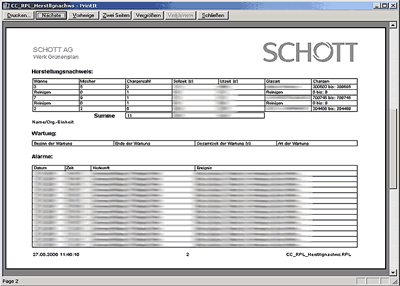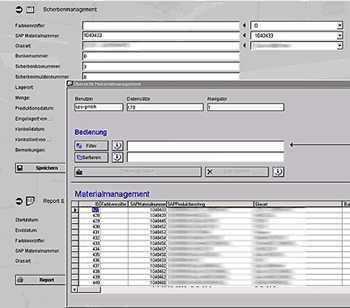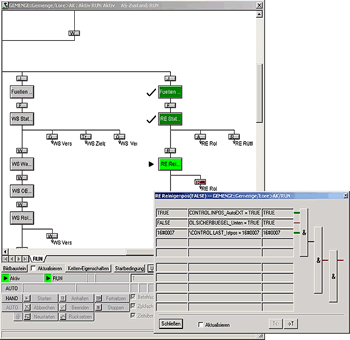Modernization of a batch plant
The process control system SIMATIC PCS7 from Siemens is the base for the batch control system
The controlling of the batch transport as well as the scales has been done with 5 operator stations with a PMS system from Philips and two machine terminals from Siemens, before we made the modernization. The operating concept from the existing plant and the experience from the staff should be the base for the modernization.
The batch control system from Schlemmer Prozess Systeme has been realized with these components:
- Overall equipment efficiency
- Creation of production plans
- Verification of manufacturing
- Master data and time registration
- Batch card
- Batch report
- Material management
- E mail or phone notification
- Cleaning and service management
- Free configuration of automatic journals and malfunction categorization
- Data exchange with business-management systems (SAP, Excel, etc.)
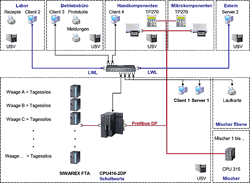
Due to a complete replacement of the control system, we needed a concept for the commissioning. The requirement was that all the hardware like silos, scales, batch transport and mixer could be used parallel from the new control system as well as the old PMS. The batch production could never be shut down longer than 8 hours per day. Due to the complexity of this plant, we calculated a commissioning of 4 weeks. Correspondingly, we invested a lot of time before commissioning to develop a good concept, which allowed us the parallel usage of the hardware of the plant. We used so called “Faceplates” for monitoring and controlling the motors, valves, measuring points etc. Faceplates are several detail-pictures, which are united to one object. These “Faceplates” are connected to the PLC program and can be opened with one mouse click from the process picture of the visualization. This results for every unit in more operating and monitoring possibilities like display of all malfunctions and operation actions in clear text, alarm options, choice of operation mode, status indication, input of parameters, setting of service interval etc.
The batch control system
The base for operation and monitoring is the process control system PCS7. Process relevant plant conditions, alarm messages and service messages are displayed on the PC. We used modules like scales, motors, valves etc. from the PCS7 library for the Schott AG plant. The charge acquisition, charge logging and charge processing take place in a SQL database. The charge data will also be transferred into the superior business-management system SAP/R3. In return, information about delivered raw material will be transferred from the SAP system into the database of the weighing system. We configured the PCS7 system redundant, to guarantee a high availability. In case of a malfunction of one server, the second server starts immediately to supply the clients with all the data. All data on the server pair are synchronized by cloning the SQL server. It is possible to access all the process data within a time of at least 10 years without any kind of restore procedure. Our batch control system overs also a lot of other features:
- Overall equipment efficiency
The duration of every production process will be saved with charge number and batch number in a database. Schott AG wanted to save all together 19 different OEE data for this plant, these data will be saved with every single charge. These data will be used to optimize production processes in further steps.
- Creation of production plans
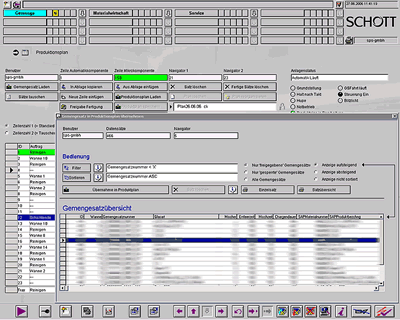
Batch sets, which have been calculated in the laboratory, are available in the form of recipes. These recipes can be used now to create production plans. The operator can select the desired set from a list and put it into the plan. In such a plan, the production can be determined for up to one week. The production plan contains for every batch set additional information like order number, destination of the charge, set amount of charges, actual amount of charges, status of processing, release, target time of processing, actual time of processing etc. The laboratory decides which batch set shall be released and which shall not be released. In case a not released batch set will be identified during production, the system is automatically looking for the highest version number for this kind of batch (kind of glass) and uses this version for the production. This batch control system uses also such features like clipboard, loading and saving of production plans, changing, deleting, importing of production plans as well as the exchange of production plans with Excel.
- Verification of manufacturing
There is the possibility to print a verification of manufacturing for every shift. The production duration can be chosen. The verification of manufacturing contains all necessary data of the produced charges. The listing can be done separately for every tank furnace. Further information like the used mixer, production duration, kind of glass as well as the charge identification numbers is included in the verification. In addition, the malfunctions or maintenances, which occurred during productions, can be listed as well.
- Master data and time registration
Verwaltung von Anlagenpersonal mit ID, Nummer, Name etc. und sonstige benötigte Daten. Für die Erstellung des zur Schicht zugehörigen Herstellungsnachweises werden die Anlagenbediener aus den Stammdaten wahlweise über deren Personalnummer oder den Namen ausgewählt. Jede Schicht wird mit Angaben zu Beginn und Ende sowie dem Namen des zugehörigen Schichtführers protokolliert. Per Mausklick kann der Personalstamm in ein Excel Arbeitsblatt exportiert werden.
A batch card can be printed automatically or manually for every charge, to be able to retrace every batch. This batch card contains among other things information about the color, tank furnace, kind of glass, operator, shift, weight of glass etc. In addition, a barcode is printed onto the batch card, to be able to simply scan it and trace the batch.
A printout will be produced for every charge manually or automatically in case of a violation of a tolerance level. Such a report contains the name of the operator, the batch duration and up to other 470 significant values of this charge. It is also possible to produce such a batch report up to 10 years later.
By means of the produced charges and the data of the delivered materials, which are supplied from the SAP system, researches about the material movement can be done. By giving a start time respectively an end time, material, kind of glass and tank furnace, it is possible to display the inlet respectively outlet of material, raw material consumption of a tank furnace, tolerance values of single components etc. Like all other functions in PCS7, it is very easy to get to a result within a few mouse clicks. All researches and results can be exported to Excel.
- E mail or phone notification
An e mail will be sent to a configured number of users, in case of abnormalities in the plant. Besides the name and the e mail address of the addressee, the subject of the e mail as well as the text of the message can be configured. For example, the company Schott AG wanted to be informed immediately, in case any problem occurs with data exchange between the automation system and the SAP system. Next to the possibility of e mail notification it is also possible to get notifications via SMS and fax.
- Cleaning and service management
All performed cleaning and service jobs, which has been done at the plant, will be logged with begin, end, kind of cleaning/service as well as a subscribing text. With such a log file, it is easy to find out which jobs has been unnecessary and which jobs must be done in defined intervals. A paper can be printed manually or automatically at the end of every shift.
All necessary adjustments for the path of the computer drives and the automatic printing of the protocols etc. are free to configure, but only with the necessary authorization. In addition, there is a categorization of malfunction included in the system. That means, the plant will be separated into several parts and the beginning of any malfunction, the end of any malfunction and the down time etc. of every part will be protocolled and confirmed separately. With this separation it is easy to find weak parts of the plant and with knowing the weak part it is easy to optimize the plant.
The batch control system has been connected to a NOVELL server for data exchange reasons. Schott AG wanted to realize an operation of the plant even without the plant PC’s. Therefore, we created a concept which allowed also a PC, which wasn’t directly connected to the control system, to send recipes, which can contain up to 470 values, directly into the PLC. The desired recipes can be copied from any computer onto a “CF” card. The recipes will be transferred via a special control panel, which is connected per PROFIBUS to the control system. All manual functions, the control of weighing procedures as well as malfunction analysis can also be done from this control panel, in case of auxiliary operation or emergency operation.
Weighing and dosing control
The basic programming language in PCS7 systems is the so called “continuous function chart” CFC. The desired functions result out of connecting graphic modules. This kind of programming leads to a faster solution than programming with text. The programming of processes is done with the so called “sequential function chart” SFC. This graphic programming tool allows us to subscribe the process by means of steps and transitions. Such a SFC procedure can be opened from the visualization with a mouse click. The current process state will be indicated with colors. The colors can be assigned to the appropriate states. An error source, which can result in a down time, can be found and eliminated very fast and easy with this tool.
The raw materials, which have to be dosed, are assigned to a silo. This silo can be parameterized by means of a configuration dialog. Every raw material gets for every weighing process a data set – fineness, kind of dosing, allocation to a scale, SAP number etc. The raw material with the current condition is displayed separately for every scale in the status display of the current dosing job.
One scale will be unloaded before another one, depending on the priority level. That means a raw material with higher priority will be successfully weighed before another one with lower priority.
Due to the exchange of the weighing and dosing technology to the batch control system of Schlemmer Prozess Systeme, Schott AG has all options for the future regarding expandability, servicing and cost minimization. The problem of depending on one supplier belongs to the past. Schlemmer Prozess Systeme is your competent partner for automation solutions. We help customers in the inland and abroad to realize their projects.



